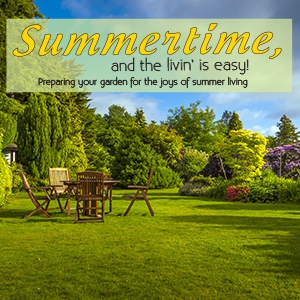Preparing your garden for the joys of summer living. Spring is a notable time in any garden. It is not difficult to see that everything is coming back to life after the cold chills of winter. As the days get longer, the soil temperatures go up, and this triggers renewed life.
It is also possibly the nicest time of year for us to enjoy our gardens; however, this does come at a price. This month’s article will look at a number of the past articles in a quick review as routine maintenance is what will ensure an amazing summer garden.
Over the past few months we have touched on irrigation, fertilization, turf maintenance, tree maintenance, and seed sowing. It is now time to start putting all those elements into practice.
Water – not too much, not too little
As the temperatures warm it is evident that one of the most important factors in our gardens is the need for water.
It is time for you to start observing just how much moisture is available to your plants. It is a good idea to put mulch over your beds as this slows down evaporation and weed growth – two factors that are responsible for the biggest moisture loss in our gardens.
If you haven’t mulched it is easy to see that the soil surface dries out very quickly. This causes the underlying moisture to percolate upwards, pulling the water away from the root zone of the plants.
Mulching with either wood chips or leaf litter provides a thermal blanket which slows down moisture evaporation and weed growth. A good mulch depth is between five and eight centimetres. It is good to remember that roses perform far better if they are mulched.
 It is important to determine how much, and how often, to water our garden. The irrigation term for this is water scheduling. Scheduling is the determining of the frequency of irrigation, whether that be manual or automatic. As we know not all plants require the same amount of water.
It is important to determine how much, and how often, to water our garden. The irrigation term for this is water scheduling. Scheduling is the determining of the frequency of irrigation, whether that be manual or automatic. As we know not all plants require the same amount of water.
Established trees would require much less water than shrubs and annuals. The best way to determine how much, and how often, we should water, are signs of water stress on our plants. These signs are a dulling of the leaf colour, and wilting. These are clear indicators that our plants need water. It is a good practice to do our watering in the early morning or late evening as less of the water is lost through heat evaporation.
 If you have an irrigation system, it might also be a good idea to remember that this also requires maintenance. Sprinklers and emitters need to be cleaned out and unclogged as this influences the quality of water flow. Roots might have grown into the drippers, and most shrub heads and sprinklers have a little sieve inside of them which filters dirt particles from the water, and these need to be cleaned out. Timers and solenoids need to be checked to ensure that they are in good working order.
If you have an irrigation system, it might also be a good idea to remember that this also requires maintenance. Sprinklers and emitters need to be cleaned out and unclogged as this influences the quality of water flow. Roots might have grown into the drippers, and most shrub heads and sprinklers have a little sieve inside of them which filters dirt particles from the water, and these need to be cleaned out. Timers and solenoids need to be checked to ensure that they are in good working order.
One thing we do far too often is water indiscriminately. As water is a scarce commodity in South Africa, it is high time we only provide as much water as is required. Those of you with automated systems must remember to vary the quantities and frequencies of irrigation cycles to match the actual requirements of your garden.
Green, green grass
The next bugbear faced by many of us is the acceleration in the growth of our turf. It’s time to pull out the old mower and trimmer, and ensure that they are in good working order. I have found that by cutting on a weekly basis this helps keep lawns neat and tidy, and also eliminates a large number of those pesky weeds. This also reduces the need to administer copious quantities of chemicals.
One might note that at this time of year, our lawns aren’t looking as good as we would like them to. Spring treatment is the necessary step to that healthy lawn.
 A lot of people think that top dressing is the first step in spring maintenance. This, however, is not necessarily the case as top dressing is only there to rectify levelling problems. It is not a means of fertilising. The only areas that would require top dressing are those that have been excessively worn, i.e. bare patches. These are remedied by either spike rolling or hollow tining.
A lot of people think that top dressing is the first step in spring maintenance. This, however, is not necessarily the case as top dressing is only there to rectify levelling problems. It is not a means of fertilising. The only areas that would require top dressing are those that have been excessively worn, i.e. bare patches. These are remedied by either spike rolling or hollow tining.
However, if our lawns are small, this tining can be achieved by pushing a garden fork into the compacted soil and shattering it. Do not turn the soil – the fork is pushed into the ground and then pushed forwards, fracturing the hard soil surface. This tining helps with water percolation to the root zone, and thus stimulates the rhizomes and promotes leaf growth.
After tining a light top dressing consisting of 50% coarse sand, and 50% compost, should be applied to those bare patches bringing the level up to that of the surrounding lawn.
Fertilising with 3:1:5 fertiliser at a rate of between 60 and 80 grams per square meter, would be just the boost your lawn needs to shake off the winter blues. This will be continued every second month throughout spring and summer. After fertilising, please remember to water well, thus eliminating fertiliser burn.
I know there is a growing trend to use organic fertilisers and often people are caught up with the idea of compost as the only organic fertiliser. However, there are other forms of organic fertiliser alternatives available in the market place that accurately simulates almost all the chemical fertilisers.
Unwanted visitors – dealing with weeds and pests
A lot of us dread spring, as we know this comes with a certain amount of gardening work. The gardeners, however, look at this as a time to knuckle down and enjoy their gardening.
At this time of the year there is a proliferation of weeds and turf encroachment into our flowerbeds. It is a good idea to redefine our bed edges and if we have not already done so, it might be a good time to put in a border edging to prevent lawns from sneaking into our flowerbeds. An easy way to do this is by buying Damp Course from our local hardware store. A narrow trench is dug on the edge of our beds and a twenty millimetre wide strip of Damp Course is inserted vertically into this trench and back filled. This provides a barrier to prevent those pesky turf roots from sneaking through.
If we have mulched, weeding should be a breeze. However, if we haven’t mulched, now is the time to bend that back and pull out those weeds. It might be time-consuming, but it’s great therapy.
During this time of the year you might notice the following critters: lawn caterpillar, crickets, and snails. There are many handy-pack remedies available at your local nursery or supermarket that will effectively eliminate these pests.
Maintenance of other garden elements

With regard to the maintenance of other garden elements, depending on the nature and structure of your garden, and the zones you have already chosen, it might be easiest to look at the garden from the following perspective: your biggest elements through to your smallest elements, starting with trees, and ending with annuals.
Tree maintenance for mature trees is relatively easy. The only aspects we really need to consider are damaged or diseased branches. Damaged or diseased branches can easily be removed with a pruning saw. But, if the limbs are too large, or too high, to remedy in this way, it would be prudent to seek professional assistance.
Fruit trees should be getting blooms or possibly young fruit. It would be a good idea to monitor these for signs of insect infestation. Any signs that your new crop is about to be devastated by unwanted critters would have to be dealt with chemically and as a matter of urgency. If you cannot identify the pest concerned, consult a professional for the appropriate identification and remedy. I know the trend is to go organic, and that many people are reluctant to use chemicals in their gardens. However, sometimes (and this is one of them), a quick remedial treatment is far easier than handling an epidemic. Early detection and action equals minimal need for chemicals.
You might also want to prune off lower branches in order to allow easier movement under the trees or to create protected shady zones for gardening. Remember, the new trees we have just planted need to be monitored with respect to water needs as they are not yet self-sufficient. It is also an easy time to shape these young trees as this needs only be done at this stage with a secateurs and light pruning saw. It is best to do this when these trees are still young. If shaping is left until trees are mature, this then becomes the job for an expert.
Shrubs are normally the intermediate plant zones in our garden. These, because of their size, are normally the most visually prominent element as they are of a similar scale to ourselves. They give bold colour and accent, and provide screens. They also tend to grow into one another, and would thus need pruning or cutting back to keep them in their place.
Perennials tend to clump and get thick as they age. It might be necessary to take them out and split them, thus rejuvenating and invigorating these plants.
Our winter blooms are nearing the end of their lives, and it is time to start deciding what we are going to replace them with. Annuals are the pretty pretties in our gardens. Unfortunately, most of these are season specific and it is always exciting to decide on what colours and shapes will replace those poor old blooms.

All the border areas and flowerbeds can be fertilised with a general broad-spectrum fertiliser such as 3:1:5 or 3:2:3 on a bi-monthly cycle. Old mulch can be supplemented with compost, and this too can be dug into the beds. This will improve the soil texture and structure, and allow us to put in new, fresh mulch which helps give a clean, finished appearance.
This should give you all an idea of the work needing to be done. After you’ve done this, it will leave you with plenty of time to take to that deck chair, put your feet up, and enjoy your simple summer garden.
The bees are buzzing, the birds are a ’twitter, and spirits are high. Nothing beats long lazy lunches under the trees with friends and loved ones. Your garden is that extra room you never got a chance to build, so get out and enjoy it.
Happy gardening!
Credit – Plaastoe.co.za

